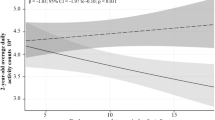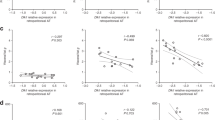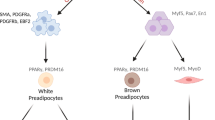Abstract
Background:
Environmental exposures during critical periods of prenatal and early postnatal life affect the development of mammalian body weight regulatory mechanisms, influencing lifelong risk of obesity. The specific biological processes that mediate the persistence of such effects, however, remain poorly understood.
Objective:
The objectives of this study were to determine the developmental timing and physiological basis of the obesity-promoting effect previously reported in offspring of obese agouti viable yellow (Avy/a) mothers.
Design:
Newborn offspring of obese Avy/a and lean (a/a) mothers were cross-fostered shortly after birth to study separately the effects of in utero or suckling period exposure to Avy/a dams. Body composition, food intake, physical activity and energy expenditure were measured in offspring shortly after weaning and in adulthood.
Results:
Offspring of obese Avy/a dams paradoxically experienced fetal growth restriction, which was followed by adult-onset obesity specifically in females. Our main analyses focused on wild-type (a/a) offspring, because a subset of adult Avy/a offspring contracted a kidney disease resembling diabetic nephropathy. Detailed physiological characterization demonstrated that, both shortly after weaning and in adulthood, female wild-type mice born to Avy/a mothers are not hyperphagic but have reduced physical activity and energy expenditure. No such coordinated changes were detected in male offspring. Mediational regression analysis of our longitudinal data supported a causal pathway in which fetal growth restriction persistently reduces physical activity, leading to adult obesity.
Conclusions:
Our data are consistent with several recent human epidemiological studies showing female-specific effects of perinatal nutritional restriction on later obesity, and provide the novel mechanistic insight that this may occur via permanent and sex-specific changes in one’s inherent propensity for physical activity.
This is a preview of subscription content, access via your institution
Access options
Subscribe to this journal
Receive 12 print issues and online access
$259.00 per year
only $21.58 per issue
Buy this article
- Purchase on Springer Link
- Instant access to full article PDF
Prices may be subject to local taxes which are calculated during checkout




Similar content being viewed by others
References
Finucane MM, Stevens GA, Cowan MJ, Danaei G, Lin JK, Paciorek CJ et al. National, regional, and global trends in body-mass index since 1980: systematic analysis of health examination surveys and epidemiological studies with 960 country-years and 9.1 million participants. Lancet 2011; 377: 557–567.
Atkinson RL, Pietrobelli A, Uauy R, Macdonald IA . Are we attacking the wrong targets in the fight against obesity?: the importance of intervention in women of childbearing age. Int J Obes 2012; 36: 1259–1260.
Gluckman PD, Hanson M, Zimmet P, Forrester T . Losing the war against obesity: the need for a developmental perspective. Sci Transl Med 2011; 3: 93cm19.
Cnattingius S, Villamor E, Lagerros YT, Wikstrom AK, Granath F . High birth weight and obesity: a vicious circle across generations. Int J Obes 2012; 36: 1320–1324.
Gluckman PD, Hanson MA . Living with the past: evolution, development, and patterns of disease. Science 2004; 305: 1733–1736.
Ong KK, Ahmed ML, Emmett PM, Preece MA, Dunger DB . Association between postnatal catch-up growth and obesity in childhood: prospective cohort study. BMJ 2000; 320: 967–971.
Robinson WR . Gender-specific effects of early nutritional restriction on adult obesity risk: evidence from quasi-experimental studies. Obesity 2012; 20: 2464–2466.
Stein AD, Kahn HS, Rundle A, Zybert PA, van der Pal-de Bruin K, Lumey LH . Anthropometric measures in middle age after exposure to famine during gestation: evidence from the Dutch famine. Am J Clin Nutr 2007; 85: 869–876.
Yang Z, Zhao W, Zhang X, Mu R, Zhai Y, Kong L et al. Impact of famine during pregnancy and infancy on health in adulthood. Obes Rev 2008; 9 (Suppl 1): 95–99.
Hult M, Tornhammar P, Ueda P, Chima C, Bonamy AK, Ozumba B et al. Hypertension, diabetes and overweight: looming legacies of the Biafran famine. PLoS One 2010; 5: e13582.
Kinzler WL, Vintzileos AM . Fetal growth restriction: a modern approach. Curr Opin Obstet Gynecol 2008; 20: 125–131.
Popkin BM, Adair LS, Ng SW . Global nutrition transition and the pandemic of obesity in developing countries. Nutr Rev 2012; 70: 3–21.
Jones AP, Friedman MI . Obesity and adipocyte abnormalities in offspring of rats undernourished during pregnancy. Science 1982; 215: 1518–1519.
Ross MG, Beall MH . Adult sequelae of intrauterine growth restriction. Semin Perinatol 2008; 32: 213–218.
Waterland RA, Travisano M, Tahiliani KG, Rached MT, Mirza S . Methyl donor supplementation prevents transgenerational amplification of obesity. Int J Obes 2008; 32: 1373–1379.
Duhl DM, Vrieling H, Miller KA, Wolff GL, Barsh GS . Neomorphic agouti mutations in obese yellow mice. Nat Genet 1994; 8: 59–65.
Wolff GL, Roberts DW, Mountjoy KG . Physiological consequences of ectopic agouti gene expression: the yellow obese mouse syndrome. Physiol Genomics 1999; 1: 151–163.
Wolff GL, Kodell RL, Moore SR, Cooney CA . Maternal epigenetics and methyl supplements affect agouti gene expression in Avy/a mice. FASEB J 1998; 12: 949–957.
Aubert R, Suquet JP, Lemonnier D . Long-term morphological and metabolic effects of early under- and over-nutrition in mice. J Nutr 1980; 110: 649–661.
Waterland RA, Jirtle RL . Transposable elements: targets for early nutritional effects on epigenetic gene regulation. Mol Cell Biol 2003; 23: 5293–5300.
Morgan HD, Sutherland HG, Martin DI, Whitelaw E . Epigenetic inheritance at the agouti locus in the mouse [see comments]. Nat Genet 1999; 23: 314–318.
Dolinoy DC, Weidman JR, Waterland RA, Jirtle RL . Maternal genistein alters coat color and protects Avy mouse offspring from obesity by modifying the fetal epigenome. Environ Health Perspect 2006; 114: 567–572.
Kaiyala KJ, Schwartz MW . Toward a more complete (and less controversial) understanding of energy expenditure and its role in obesity pathogenesis. Diabetes 2011; 60: 17–23.
Baron RM, Kenny DA . The moderator-mediator variable distinction in social psychological research: conceptual, strategic, and statistical considerations. J Pers Soc Psychol 1986; 51: 1173–1182.
Rasmussen KM . Association of maternal obesity before conception with poor lactation performance. Annu Rev Nutr 2007; 27: 103–121.
Brosius FC 3rd, Alpers CE . New targets for treatment of diabetic nephropathy: what we have learned from animal models. Curr Opin Nephrol Hypertens 2013; 22: 17–25.
Xiao XQ, Williams SM, Grayson BE, Glavas MM, Cowley MA, Smith MS et al. Excess weight gain during the early postnatal period is associated with permanent reprogramming of brown adipose tissue adaptive thermogenesis. Endocrinology 2007; 148: 4150–4159.
Vickers MH, Breier BH, Cutfield WS, Hofman PL, Gluckman PD . Fetal origins of hyperphagia, obesity, and hypertension and postnatal amplification by hypercaloric nutrition. Am J Physiol Endocrinol Metab 2000; 279: E83–E87.
Simmons RA, Templeton LJ, Gertz SJ . Intrauterine growth retardation leads to the development of type 2 diabetes in the rat. Diabetes 2001; 50: 2279–2286.
Hendrix N, Berghella V . Non-placental causes of intrauterine growth restriction. Semin Perinatol 2008; 32: 161–165.
Wallace JM, Horgan GW, Bhattacharya S . Placental weight and efficiency in relation to maternal body mass index and the risk of pregnancy complications in women delivering singleton babies. Placenta 2012; 33: 611–618.
Gaillard R, Durmus B, Hofman A, Mackenbach JP, Steegers EA, Jaddoe VW . Risk factors and outcomes of maternal obesity and excessive weight gain during pregnancy. Obesity 2013; 21: 1046–1055.
Kennedy GC . The development with age of hypothalamic restraint upon the appetite of the rat. J Endocrinol 1957; 16: 9–17.
Ravelli GP, Stein ZA, Susser MW . Obesity in young men after famine exposure in utero and early infancy. N Engl J Med 1976; 295: 349–353.
Vickers MH, Breier BH, McCarthy D, Gluckman PD . Sedentary behavior during postnatal life is determined by the prenatal environment and exacerbated by postnatal hypercaloric nutrition. Am J Physiol Regul Integr Comp Physiol 2003; 285: R271–R273.
Bellinger L, Sculley DV, Langley-Evans SC . Exposure to undernutrition in fetal life determines fat distribution, locomotor activity and food intake in ageing rats. Int J Obes 2006; 30: 729–738.
Khan IY, Taylor PD, Dekou V, Seed PT, Lakasing L, Graham D et al. Gender-linked hypertension in offspring of lard-fed pregnant rats. Hypertension 2003; 41: 168–175.
Li G, Kohorst JJ, Zhang W, Laritsky E, Kunde-Ramamoorthy G, Baker MS et al. Early postnatal nutrition determines adult physical activity and energy expenditure in female mice. Diabetes 2013; 62: 2773–2783.
Bauman AE, Reis RS, Sallis JF, Wells JC, Loos RJ, Martin BW et al. Correlates of physical activity: why are some people physically active and others not? Lancet 2012; 380: 258–271.
Garland T Jr ., Schutz H, Chappell MA, Keeney BK, Meek TH, Copes LE et al. The biological control of voluntary exercise, spontaneous physical activity and daily energy expenditure in relation to obesity: human and rodent perspectives. J Exper Biol 2011; 214 (Pt 2): 206–229.
Gluckman PD, Hanson MA, Buklijas T, Low FM, Beedle AS . Epigenetic mechanisms that underpin metabolic and cardiovascular diseases. Nat Rev Endocrinol 2009; 5: 401–408.
Bouret SG, Draper SJ, Simerly RB . Trophic action of leptin on hypothalamic neurons that regulate feeding. Science 2004; 304: 108–110.
Lenz KM, McCarthy MM . Organized for sex—steroid hormones and the developing hypothalamus. Eur J Neurosci 2010; 32: 2096–2104.
Levine JA . Non-exercise activity thermogenesis. Proc Nutr Soc 2003; 62: 667–679.
Andersen LG, Angquist L, Gamborg M, Byberg L, Bengtsson C, Canoy D et al. Birth weight in relation to leisure time physical activity in adolescence and adulthood: meta-analysis of results from 13 nordic cohorts. PLoS One 2009; 4: e8192.
Said-Mohamed R, Bernard JY, Ndzana AC, Pasquet P . Is overweight in stunted preschool children in Cameroon related to reductions in fat oxidation, resting energy expenditure and physical activity? PLoS One 2012; 7: e39007.
Kohl HW 3rd, Craig CL, Lambert EV, Inoue S, Alkandari JR, Leetongin G et al. The pandemic of physical inactivity: global action for public health. Lancet 2012; 380: 294–305.
Acknowledgements
We thank Adam Gillum (USDA/ARS CNRC) for assistance with the figures and Firoz Vohra (USDA/ARS CNRC) for assistance with the CLAMS studies. MSB conducted research and wrote the paper; GL and JJK conducted research; RAW designed research, analyzed data, wrote the paper and had primary responsibility for final content. This work was supported by grants from NIH/NIDDK (1R01DK081557) and USDA (CRIS 6250–51000–055) to RAW. The body composition and CLAMS studies were performed in the Mouse Metabolic Research Unit at the USDA/ARS Children’s Nutrition Research Center, which is supported by funds from the USDA/ARS.
Author information
Authors and Affiliations
Corresponding author
Ethics declarations
Competing interests
The authors declare no conflict of interest.
Additional information
Supplementary Information accompanies this paper on International Journal of Obesity website
Supplementary information
Rights and permissions
About this article
Cite this article
Baker, M., Li, G., Kohorst, J. et al. Fetal growth restriction promotes physical inactivity and obesity in female mice. Int J Obes 39, 98–104 (2015). https://doi.org/10.1038/ijo.2013.146
Received:
Revised:
Accepted:
Published:
Issue Date:
DOI: https://doi.org/10.1038/ijo.2013.146
Keywords
This article is cited by
-
DNA Methylation Analysis of Imprinted Genes in the Cortex and Hippocampus of Cross-Fostered Mice Selectively Bred for Increased Voluntary Wheel-Running
Behavior Genetics (2022)
-
Maternal obesity induces liver lipid accumulation of offspring through the lncRNA Lockd/mTOR autophagy pathway
Molecular Genetics and Genomics (2022)
-
A butanolic fraction from the standardized stem extract of Cassia occidentalis L delivered by a self-emulsifying drug delivery system protects rats from glucocorticoid-induced osteopenia and muscle atrophy
Scientific Reports (2020)
-
Early sonographic evaluation of the placenta in cases with IUGR: a pilot study
Archives of Gynecology and Obstetrics (2020)
-
DNA methylation in AgRP neurons regulates voluntary exercise behavior in mice
Nature Communications (2019)



